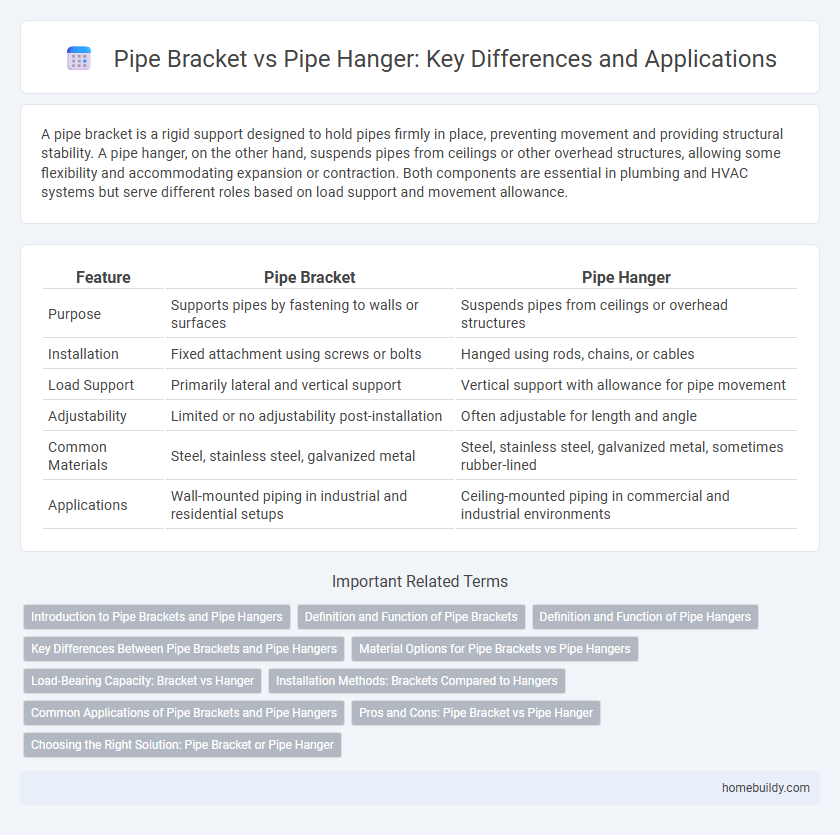A pipe bracket is a rigid support designed to hold pipes firmly in place, preventing movement and providing structural stability. A pipe hanger, on the other hand, suspends pipes from ceilings or other overhead structures, allowing some flexibility and accommodating expansion or contraction. Both components are essential in plumbing and HVAC systems but serve different roles based on load support and movement allowance.
Table of Comparison
| Feature | Pipe Bracket | Pipe Hanger |
|---|---|---|
| Purpose | Supports pipes by fastening to walls or surfaces | Suspends pipes from ceilings or overhead structures |
| Installation | Fixed attachment using screws or bolts | Hanged using rods, chains, or cables |
| Load Support | Primarily lateral and vertical support | Vertical support with allowance for pipe movement |
| Adjustability | Limited or no adjustability post-installation | Often adjustable for length and angle |
| Common Materials | Steel, stainless steel, galvanized metal | Steel, stainless steel, galvanized metal, sometimes rubber-lined |
| Applications | Wall-mounted piping in industrial and residential setups | Ceiling-mounted piping in commercial and industrial environments |
Introduction to Pipe Brackets and Pipe Hangers
Pipe brackets and pipe hangers are essential components in piping systems, designed to support and secure pipes while accommodating different load requirements and installation conditions. Pipe brackets typically provide rigid support by attaching pipes to walls or structures, minimizing movement and preventing vibrations. In contrast, pipe hangers suspend pipes from ceilings or beams, offering flexibility to accommodate thermal expansion and pipe movement.
Definition and Function of Pipe Brackets
Pipe brackets are rigid supports designed to secure pipes firmly to walls or structures, preventing movement and maintaining alignment. Unlike pipe hangers, which suspend pipes from ceilings or beams to allow vertical adjustment and flexibility, pipe brackets provide fixed positioning and often bear heavier loads. Their primary function is to ensure stability and protection of piping systems in various industrial and residential installations.
Definition and Function of Pipe Hangers
Pipe hangers secure pipes to structural elements, supporting vertical and lateral loads while minimizing stress and vibration. Unlike pipe brackets, which typically provide rigid support and positioning, pipe hangers allow limited movement to accommodate pipe expansion and contraction. Their primary function is to ensure pipe alignment and stability, preventing sagging and damage in plumbing and mechanical systems.
Key Differences Between Pipe Brackets and Pipe Hangers
Pipe brackets provide rigid support by securing pipes directly to a surface, ensuring minimal movement and enhanced stability, while pipe hangers suspend pipes from ceilings or structures, allowing for vertical flexibility and load distribution. Pipe brackets are ideal for fixed attachment points with higher load-bearing capacity, whereas pipe hangers accommodate pipe expansion and contraction through adjustable components. The choice between pipe brackets and pipe hangers depends on installation requirements, weight support, and the need for pipe movement accommodation.
Material Options for Pipe Brackets vs Pipe Hangers
Pipe brackets are commonly made from materials such as carbon steel, stainless steel, and galvanized steel, offering robust support for various pipe sizes and weights. Pipe hangers typically use similar materials but often incorporate flexible components like rubber or spring-loaded elements to accommodate pipe movement and vibration. Material selection for pipe brackets emphasizes rigidity and load-bearing capacity, while pipe hangers prioritize flexibility and adaptability in dynamic environments.
Load-Bearing Capacity: Bracket vs Hanger
Pipe brackets generally offer higher load-bearing capacity compared to pipe hangers due to their rigid, fixed mounting design that provides enhanced support and stability for heavy pipes. While pipe hangers suspend pipes from overhead structures using flexible connections, their load capacity is often limited by the strength of the hanger material and attachment method. In industrial applications requiring substantial weight support, pipe brackets are preferred for their ability to distribute loads more effectively and reduce pipe movement.
Installation Methods: Brackets Compared to Hangers
Pipe brackets are typically installed by securing them directly to walls or structural surfaces using bolts or screws, providing rigid support for pipes. In contrast, pipe hangers are suspended from ceilings or beams with rods or straps, allowing for flexibility and movement to accommodate thermal expansion. The installation method of pipe brackets results in a more fixed position, while pipe hangers offer dynamic support to mitigate stress on piping systems.
Common Applications of Pipe Brackets and Pipe Hangers
Pipe brackets provide sturdy support for pipes in fixed positions, commonly used in wall-mounted plumbing and HVAC systems to prevent lateral movement. Pipe hangers suspend pipes from ceilings or beams, ideal for overhead piping in commercial buildings and industrial facilities where vertical clearance is necessary. Both components ensure structural integrity in piping networks, with pipe brackets preferred for fixed alignment and pipe hangers for flexible suspension.
Pros and Cons: Pipe Bracket vs Pipe Hanger
Pipe brackets offer robust support and secure attachment for pipes in various industrial and construction settings, providing stability without requiring overhead suspension. They are easy to install and maintain, especially for horizontal pipe runs, but may limit flexibility in movement and thermal expansion compared to pipe hangers. Pipe hangers accommodate vertical load support and allow for pipe movement, reducing stress on the piping system, yet they can be more complex to install and may require additional hardware or adjustments over time.
Choosing the Right Solution: Pipe Bracket or Pipe Hanger
Pipe brackets provide rigid support by securing pipes firmly against surfaces, ideal for preventing lateral movement in heavy-duty piping systems. Pipe hangers allow for vertical support and accommodate thermal expansion by suspending pipes from ceilings or beams, reducing stress on the piping network. Selecting between pipe brackets and pipe hangers depends on load requirements, installation environment, and the need for flexibility versus stability in the piping infrastructure.
pipe bracket vs pipe hanger Infographic

 homebuildy.com
homebuildy.com